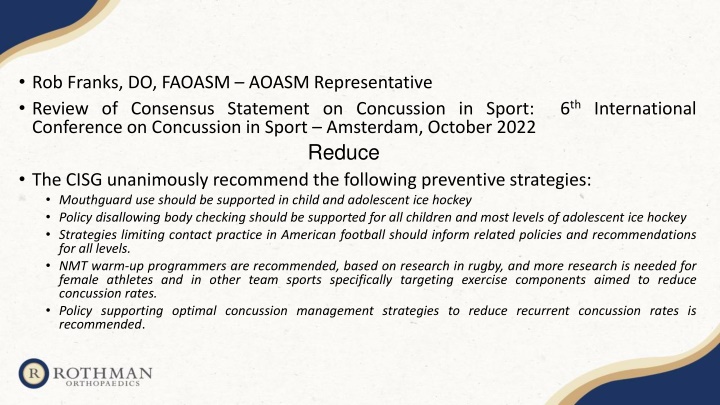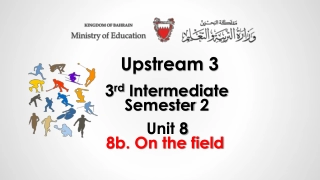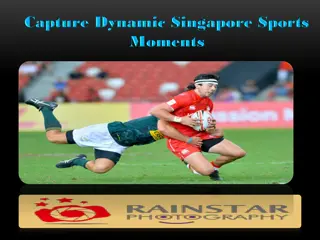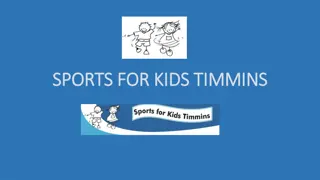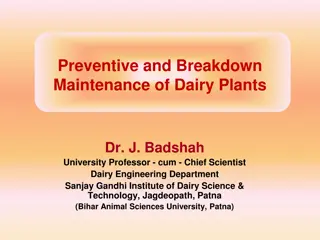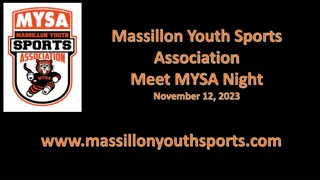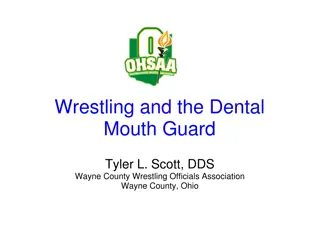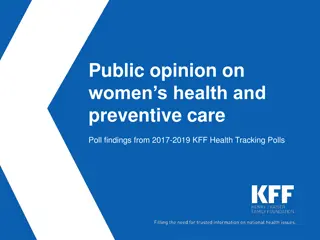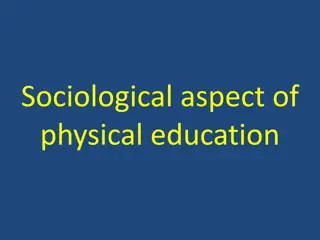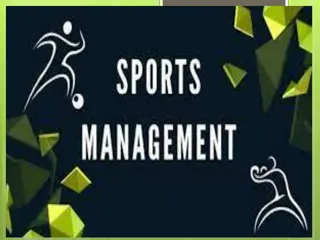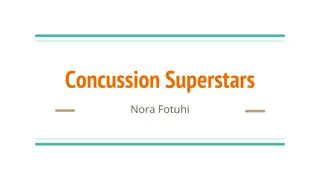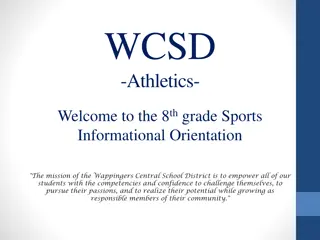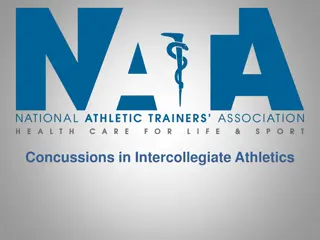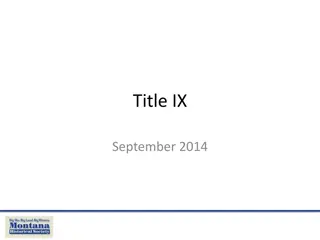Preventive Strategies for Concussion in Sports
This review highlights preventive strategies for reducing concussion rates in sports, emphasizing measures such as mouthguard use, limiting contact practices, and optimal concussion management. It also discusses the importance of recognition, removal, and office assessment tools in concussion management, along with recommendations for Return to Learn and Return to Sport strategies.
Download Presentation

Please find below an Image/Link to download the presentation.
The content on the website is provided AS IS for your information and personal use only. It may not be sold, licensed, or shared on other websites without obtaining consent from the author.If you encounter any issues during the download, it is possible that the publisher has removed the file from their server.
You are allowed to download the files provided on this website for personal or commercial use, subject to the condition that they are used lawfully. All files are the property of their respective owners.
The content on the website is provided AS IS for your information and personal use only. It may not be sold, licensed, or shared on other websites without obtaining consent from the author.
E N D
Presentation Transcript
Rob Franks, DO, FAOASM AOASM Representative Review of Consensus Statement on Concussion in Sport: Conference on Concussion in Sport Amsterdam, October 2022 6thInternational Reduce The CISG unanimously recommend the following preventive strategies: Mouthguard use should be supported in child and adolescent ice hockey Policy disallowing body checking should be supported for all children and most levels of adolescent ice hockey Strategies limiting contact practice in American football should inform related policies and recommendations for all levels. NMT warm-up programmers are recommended, based on research in rugby, and more research is needed for female athletes and in other team sports specifically targeting exercise components aimed to reduce concussion rates. Policy supporting optimal concussion management strategies to reduce recurrent concussion rates is recommended.
Remove The first step in management of SRC is recognition and removal. This removal can be based on observation of the athlete s signs and symptoms viewed by other players, healthcare providers, officials or from video. Athletes exhibiting signs and symptoms of concussion should not return to play on that same day unless evaluated by a healthcare provider with experience in concussion management who has put the athlete through a multi-modal series of tests who determines that the sign/symptom was not concussion related. The Sport Concussion Assessment Tool (SCAT6) has been shown to be the most effective test to establish whether and athlete is concussed or not and is most effective within 72 hours of injury and up to 5-7 days post-injury but utility decreases after 72 hours. The Child SCAT6 should be used in patients aged 8-12 years. Adult SCAT6 should be used for those above age 12.
Re-Evaluate: The Office Assessment The Sport Concussion Office Assessment Tool (SCOAT6 or Child SCOAT6) tools are intended for multi-modal and consecutive clinical office evaluations from 72 hours to multiple weeks post-injury. The Child SCOAT6 is used for athletes 8-12 years, while the SCOAT6 is used for athletes 13 years and older. These tests are used in conjunction with the clinical skill set and provides the clinician with a standard office multi-modal tool that can be used across practices. In addition to the SCOAT6 and Child SCOAT6, there are specific co-morbidities that must be addressed. Mental health issues that are pre-injury, associated with the SRC, or both should be screened for using validated mental health screening tools with the Sport Mental Health Assessment Tool (SMHAT) being recommended. Baseline and post-injury neurocognitive test batteries, whether done by computer or pen and paper testing may be helpful in the office assessment but should never be the sole factor from which to make clinical decisions.
Return to Learn and Sport Return to Learn Recommendations After review of the literature, 93% of athletes of all ages complete a full RTL program without additional academic intervention by 10 days. Certain conditions can make RTL more challenging including: High symptom severity Learning disability Not every athlete will need a RTL strategy In addition, RTL and RTS interventions can be completed in parallel; however, athletes should COMPLETE full RTL before RTS without restrictions. Return to Sport Recommendations: RTL and RTS can begin concurrently under a healthcare provider. Relative rest is Step One lasting 24-48 hours. Once completed, and in tandem with ADLs including activities such as walking, the following is new for 2023 and can be undertaken: Step 2A Light aerobic exercise of up to 55% of maximum heart rate Step 2B Moderate aerobic exercise of up to 70% of maximum heart rate Steps 3-6, as they may involved head contact, can be implemented upon resolution of SRC symptoms, normalization of cognitive function, and resolution of clinical concussion findings including absence of symptoms with exertion physically.
Reconsider: Potential Long-Term Effects Chronic traumatic encephalopathy-neuropathological change (CTE-NC) and traumatic encephalopathy syndrome (TES): CTE-NC (Pathology) CTE-NC is uncommon in community samples and brain banks CTE-NC is more common in former professional athletes in brain banks. These studies, often cited, are not cohort studies to look at risk or causes and not included in review for this document. TES (Clinical Diagnosis) First consensus criteria published in 2021. New criteria for diagnosis can determine extent of CTE-NC at death associated with clinical diagnosis during life. Prevalence of CTE-NC and TES in former athletes and general population is unknown.
